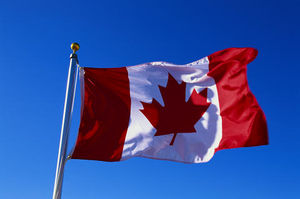Canada
Canada is a Federal Parliamentry Democracy located in the nothern half of North America. Canada was originally colonized by the French, but was annexed by the British during the Seven Years War, recieved a large influx of anglophone loyalists after the american revolution and gained self governence as a commonwealth realm with the BNA act of 1867. Canada is geographically large (a total area of 9,984,670 km2 which makes it second only to the Russian Federation in area) and resource rich, but is also a very cold region and as such is sparsely populated (Population of 34.699 million as of 2011). Despite this, Canada is (for its size) a wealthy nation which maintains reletively good relationships with the rest of the developed world. Canada has close ties with the United States (which it shares a boarder) and the United Kingdom (being a commonwealth realm). Politically Canada is moderately left wing, even with the conservative party government of PM Stephen Harper.
The Currency of Canada is the Canadian Dollar (CND).
Canadian Armed Forces
Canadian Army
Created in 1867 from the various british garrison and militia forces, the Canadian Army is the old branch of the Canadian Armed Forces. At first a defensive force, it would latter be sent abroad, starting with the Boer War. During the Great War, the Canadian Army provided soldiers to the western front in France. In several areas the Canadian Army responsible for revising tactics for the modern age (praticularly General Arther Currie), among the successes of which was the taking of Vimy Ridge.
During the Second World War, the Canadian Army played a roll in both the European and pacific theaters. Notable actions include the taking of Juno Beach.
After the Second World War, Canadian forces fought in the Korean War as well as being highly involved in various Peacekeeping operations.
Royal Canadian Air Force
The Royal Canadian Navy was formed in 1910 following the Naval Service Bill by the then Prime Minister Sir Wilfred Laurier. The bill received royal assent in May that year. King George V would rename the Department of Naval Services the Royal Canadian Navy on August 19, 1911. The first two vessels were the Diadem-class protected cruiser HMCS Niobe and the Apollo-class protected cruiser HMCS Rainbow. During both world wars, Canada provided protection to convoys headed to Britain against german submarine raids.
In it's history, Canada has operated one Colossus-class light carrier (the HMCS Warrior) and two Majestic-class light carriers (HMCS Magnificent and HMCS Bonaventure).
The Royal Canadian Navy is composed of three Iroquois-class destroyers, twelve Halifax-class patrol frigates, four Victoria-class submarines, two Protecteur-class support ships, twelve Kingston-class coastal defense vessels and eight Orca-class patrol ships. Future acquisitions for the RCN include 15 new destroyers (designated DDG), three new support ships, eight Arctic patrol ships, and a new Polar-class icebreaker to replace the current one.
Notable Canadians
- Sir Arthur Currie
- Betty Fox
- Brian Vincent Tobin
- David Lewis
- Ed Broadbent
- Elizabeth May
- Gander
- Gilles Duceppe
- Jack Layton
- Jean Charest
- John George Diefenbaker
- John Robert Osborn
- Kim Campbell
- Lester Bowles Pearson
- Marc Garneau
- Martin Brian Mulroney
- Paul Martin
- Peter Gordon Mackay
- Pierre Eliot Trudeau
- Preston Manning
- Rick Hillier
- Robert Stanfield
- Romeo Antonius Dallaire
- Stephen Harper
- Terry Fox
- Tommy Clement Douglas
- Walter Natyncyzk
- William Lyon Mackenzie King
- William Moss Landymore
Canadians SD.Net
Canada is also home to numerous SD.net Board members, including...

